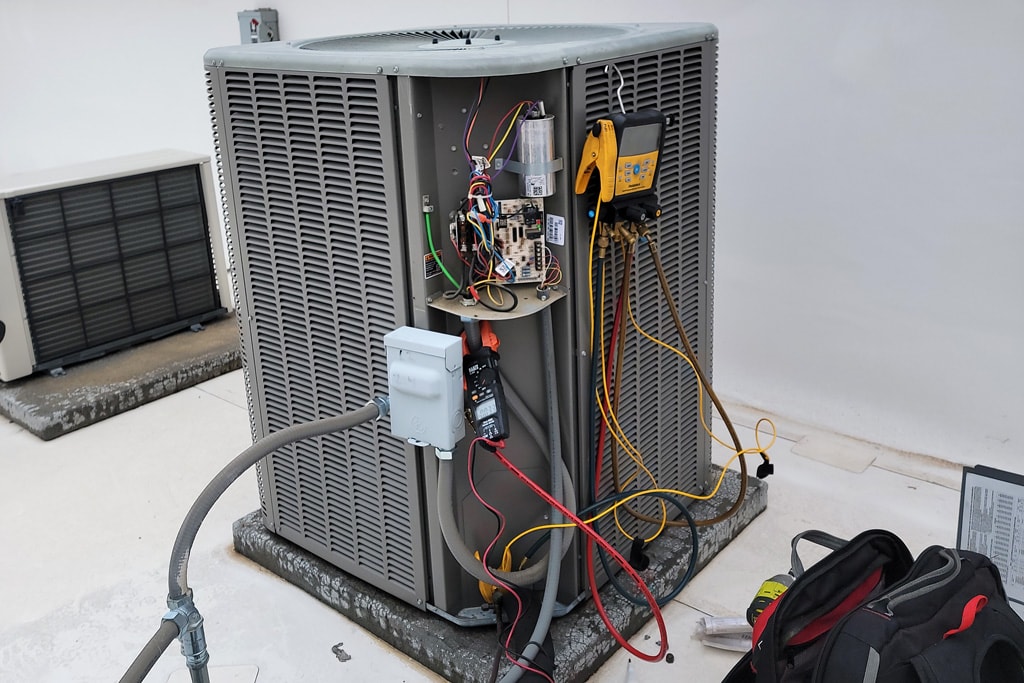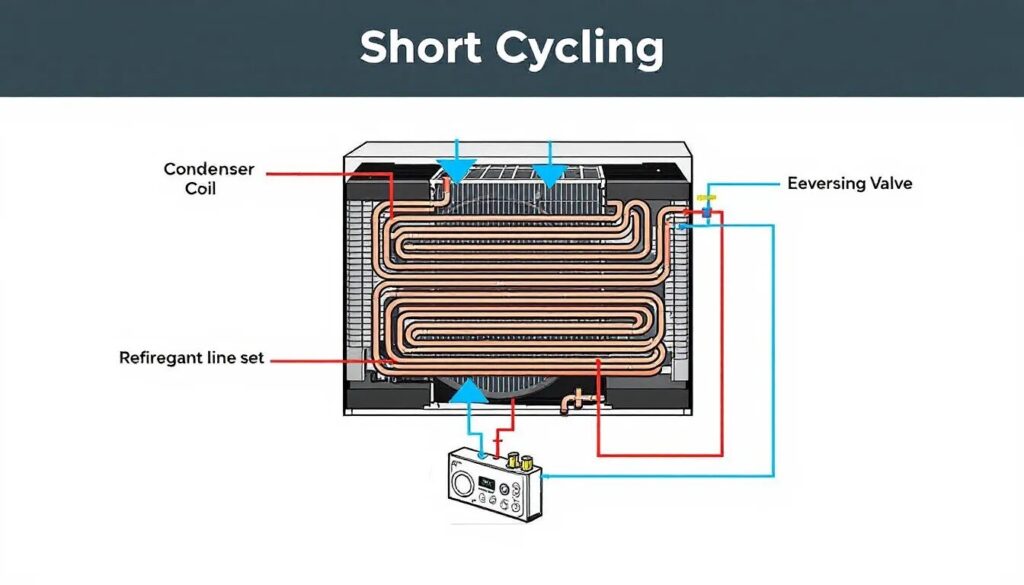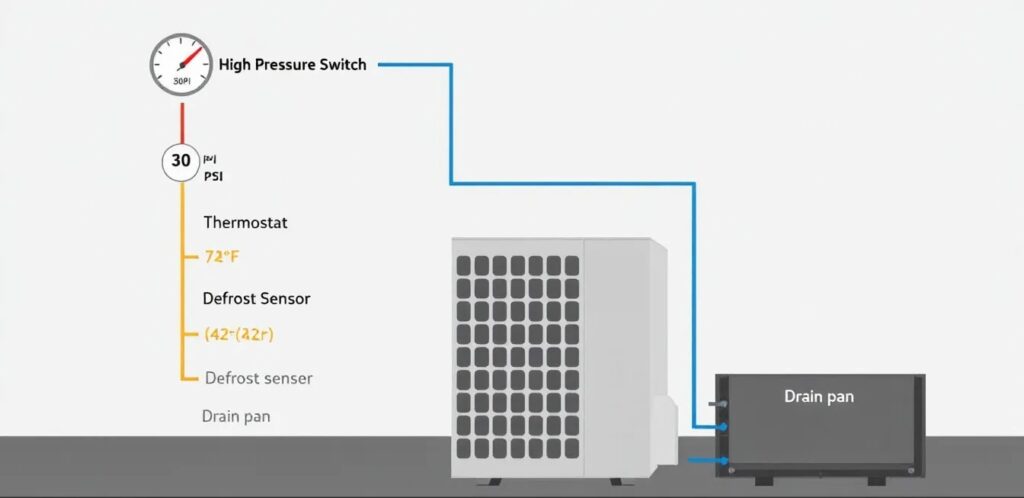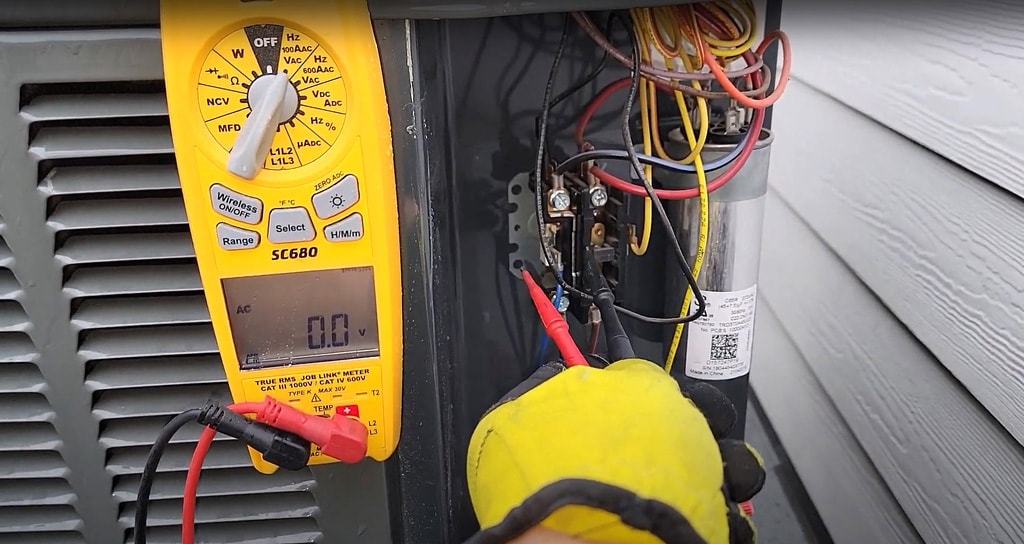
Experiencing a heat pump that starts and then shuts off quickly? Maintaining average operational durations is crucial to avoid this issue, known as short cycling, which can stem from problems like clogged air filters, thermostat malfunctions, refrigerant leaks, and more.
In this article, we’ll explore why your heat pump starts then shuts off and how to fix it, helping you get your system back to optimal performance.
Key Takeaways
- Heat pump short cycling occurs when the system turns on and off frequently, leading to efficiency loss and increased energy bills.
- Common causes of short cycling include clogged air filters, thermostat issues, refrigerant leaks, electrical problems, and incorrectly sized heat pumps.
- Regular maintenance, proper insulation, and correct thermostat settings are essential for preventing short cycling and ensuring efficient heat pump operation.
- Following the manufacturer’s recommendations for maintenance, such as regularly replacing or cleaning the air filter, can help prevent issues like high energy bills and short cycling, ensuring optimal system performance.
What Is Heat Pump Short Cycling?
Short cycling refers to a short cycling heat pump turning on and off more frequently than normal, specifically running for less than 10 minutes before shutting off. Normally, a heat pump should cycle on and off between two to six times per hour to maintain the ideal indoor temperature.
However, when it goes through short cycles, it can lead to a series of issues that affect not only your comfort but also the longevity of your system. Ideally, a heat pump should operate within a certain range to avoid these issues.

Heat pump short cycling has significant consequences that affect both efficiency and comfort levels. It places undue strain on the heat pump system, causing increased wear and tear, which can necessitate more frequent repairs and potentially lead to a complete breakdown.
Additionally, because the heat pump is constantly starting and stopping, it uses more electricity, which can substantially increase your energy bills.
To put it in perspective, a standard run time for a heat pump before cycling down should be around 15 minutes or longer. When a heat pump short cycles, it fails to complete a proper heating or cooling cycle, leading to uneven temperature distribution and inefficient operation.
Understanding the root causes of short cycling issues can help you take the necessary steps to fix the issue and ensure your heat pump operates smoothly.
Common Causes of Heat Pump Starting Then Shutting Off

Several factors can cause a heat pump to start and then shut off prematurely. Common culprits include:
- A clogged air filter
- Thermostat issues
- Refrigerant leaks
- Electrical problems
- An incorrectly sized heat pump
- Airflow blockages, such as a clogged air filter, which can block airflow and cause short cycling
Each of these problems can disrupt the normal operation of your heat pump, leading to frequent cycling and other operational issues in the process.
Clogged Air Filter
A clogged air filter is one of the most common causes of heat pump short cycling. When the air filter is clogged, it can block airflow, preventing the proper circulation of heat or cooling throughout your home.
This poor airflow can lead to ice formation on the evaporator coils, causing the heat pump to shut off as a safety precaution. Regularly changing the air filter every month is essential to prevent airflow restrictions and maintain efficient heat pump operation.
Neglecting your air filter can have serious consequences. Over time, the buildup of dirt and debris can cause the heat pump to overheat and shut down prematurely. Keeping your air filter clean ensures efficient heat pump operation, reduces the risk of short cycling, and extends the lifespan of your system.

Thermostat Issues
Another common cause of short cycling heat pump is thermostat issues. These problems can disrupt the proper functioning of the system. Incorrect settings or faulty thermostats can lead to quick cycling, causing the heat pump to constantly turn on and off as it struggles to maintain the desired temperature.
Placement is also crucial; thermostats located near windows, vents, or other heat sources can give inaccurate temperature readings, causing the heat pump to cycle unnecessarily.
Proper thermostat placement away from windows and vents can avoid these issues. Using a programmable thermostat helps maintain consistent indoor temperatures, preventing unnecessary cycling of the heat pump.
Correct thermostat settings and placement are crucial to avoiding short cycling and ensuring efficient operation.
Refrigerant Leaks
Refrigerant leaks are a serious issue that can lead to frequent heat pump cycling.
When refrigerant levels are low, the heat pump struggles to provide sufficient heating or cooling, causing it to cycle on and off frequently. This is particularly problematic in cooling mode, where maintaining the desired temperature becomes challenging. One telltale sign of a refrigerant leak is ice forming on the outdoor unit.
Refrigerant leaks can cause the compressor to overwork and overheat, leading to frequent cycling. If you suspect leaking refrigerant, contact an HVAC professional immediately to diagnose the issue, repair the leak, and recharge the system.
Electrical Problems
Electrical problems, such as loose connections or faulty wiring, can also cause heat pump short cycling. These issues can interrupt the power supply to the heat pump, causing it to shut off unexpectedly.
Loose or corroded connections in the heat pump’s electrical system can result in intermittent shutdowns and lead to short cycling issues.
A professional should diagnose and repair any electrical issues to ensure safe and efficient operation.
An Incorrectly Sized Heat Pump System
An incorrectly sized heat pump can lead to significant operational issues, including short heat pump cycling.
A heat pump that is too small struggles to maintain the desired temperature within your home or space, resulting in premature cycling.
On the other hand, an oversized heat pump can cycle frequently due to its inability to run long enough to dehumidify the air effectively.
Consult HVAC professionals to determine the correct size for your heat pump. They can perform load calculations to ensure your system is appropriately sized, preventing short cycling and ensuring efficient operation.
How to Diagnose Heat Pump Short Cycling
Diagnosing heat pump short cycling involves paying attention to specific signs and symptoms. Common signs include strange noises and uneven temperature distribution within your home. If your heat pump cycles on and off frequently without reaching the set temperature, it’s a clear indication of an underlying problem.
Troubleshooting can help identify the cause of short cycling, such as checking for a frozen evaporator coil caused by airflow issues or low refrigerant. If unsure or unable to resolve the issue, contact an HVAC professional for a thorough inspection and diagnosis.
Preventing Frequent Cycling in Heat Pumps
Preventing frequent cycling in heat pumps involves regular maintenance, proper insulation and sealing, and correct thermostat settings. These strategies help maintain efficient operation and prevent the wear and tear associated with short cycling.
Regular Maintenance
Regular maintenance checks on your heat pump can identify and rectify issues before they lead to short cycling. During a heat pump tune-up, a technician can identify electrical problems and clogged air filters, ensuring efficient operation. They inspect, calibrate, and clean components to ensure proper operation.
Simple tasks like rinsing off the outdoor unit with gentle water pressure help maintain its efficiency. Pet owners should replace their air conditioner air filter a few days sooner than usual to prevent clogs and ensure that the air flow is not blocked, which will help maintain efficient operation and keep the outdoor unit from getting dirty, following the manufacturer’s recommendations. This will rapidly help maintain the unit’s performance and work harder.
Regular maintenance is crucial to preventing short cycling and extending the lifespan of your heat pump.
Proper Insulation and Sealing
Proper insulation and sealing can significantly reduce heat loss, which helps maintain a consistent temperature and reduces the workload on the heat pump. In older houses, inadequate insulation and sealing lead to cold air infiltration, causing the heat pump to cycle frequently to maintain the set temperature and heat or cool effectively.
Adequate insulation in walls and attics mitigates temperature loss in winter, reducing the need to save energy and frequent cycling. Sealing air leaks around windows and doors prevents cold air from entering the house, minimizing cycling frequency.
Improving insulation and seal enhances the efficiency of your heat pump and prevents short cycling.
Thermostat Settings
Correct thermostat settings maintain consistent temperatures and prevent unnecessary cycling. Incorrect settings can cause the heat pump to start and shut off quickly, leading to inefficient operation. Set the thermostat to a stable temperature and avoid frequent adjustments to prevent short cycling.
Correct thermostat settings enhance comfort, improve energy efficiency, and extend the lifespan of the heat pump. Maintaining consistent settings prevents short cycling and ensures efficient operation.
When to Call an HVAC Professional

Frequent cycling can significantly reduce the lifespan of a heat pump, leading to more severe damage and higher repair costs. Homeowners should typically contact an HVAC technician if their heat pump consistently cycles on and off more than two or three times per hour during any given period.
Routine checks by HVAC professionals can detect issues like refrigerant leaks and electrical faults before they lead to short cycling. If you notice short cycling, it is a clear sign to call a professional. Regular inspections can catch potential issues early. An HVAC professional can provide a thorough diagnosis and recommend the best course of action to resolve the issue.
Call Now for HVAC Service! We’ll Restore Your Comfort!
Summary
Understanding and addressing heat pump short cycling is crucial for maintaining efficient operation and prolonging the lifespan of your system. Common causes include clogged air filters, thermostat issues, refrigerant leaks, electrical problems, and incorrectly sized heat pumps. Preventative measures such as regular maintenance, proper insulation, and correct thermostat settings can help avoid these issues.
By staying proactive with regular maintenance and seeking professional help when needed, you can ensure your heat pump operates efficiently, saving you time, money, and hassle. Keep these tips in mind to enjoy a comfortable and energy-efficient home year-round.
Frequently Asked Questions
Heat pump short cycling is when the heat pump frequently turns on and off, usually running for less than 10 minutes each time. This can lead to inefficiency and increased wear on the system.
Heat pump short cycling is often caused by clogged air filters, thermostat issues, refrigerant leaks, electrical problems, or an incorrectly sized system. Addressing these issues can significantly improve the efficiency and performance of your heat pump. Compared to furnaces, which also face operational efficiency challenges, resolving these problems in heat pumps can lead to more consistent and efficient heating.
To prevent your heat pump from short cycling, ensure regular maintenance, maintain proper insulation and sealing, and set your thermostat correctly. These steps can significantly enhance your system’s efficiency and longevity.
You should call an HVAC professional if your heat pump short cycles more than two or three times per hour, or if you observe any signs of refrigerant leaks or electrical problems. Taking timely action can prevent further damage and ensure efficient operation.
You should change your heat pump’s air filter every month to ensure optimal airflow and efficient operation. Regular maintenance will help prevent issues and prolong the life of your system.